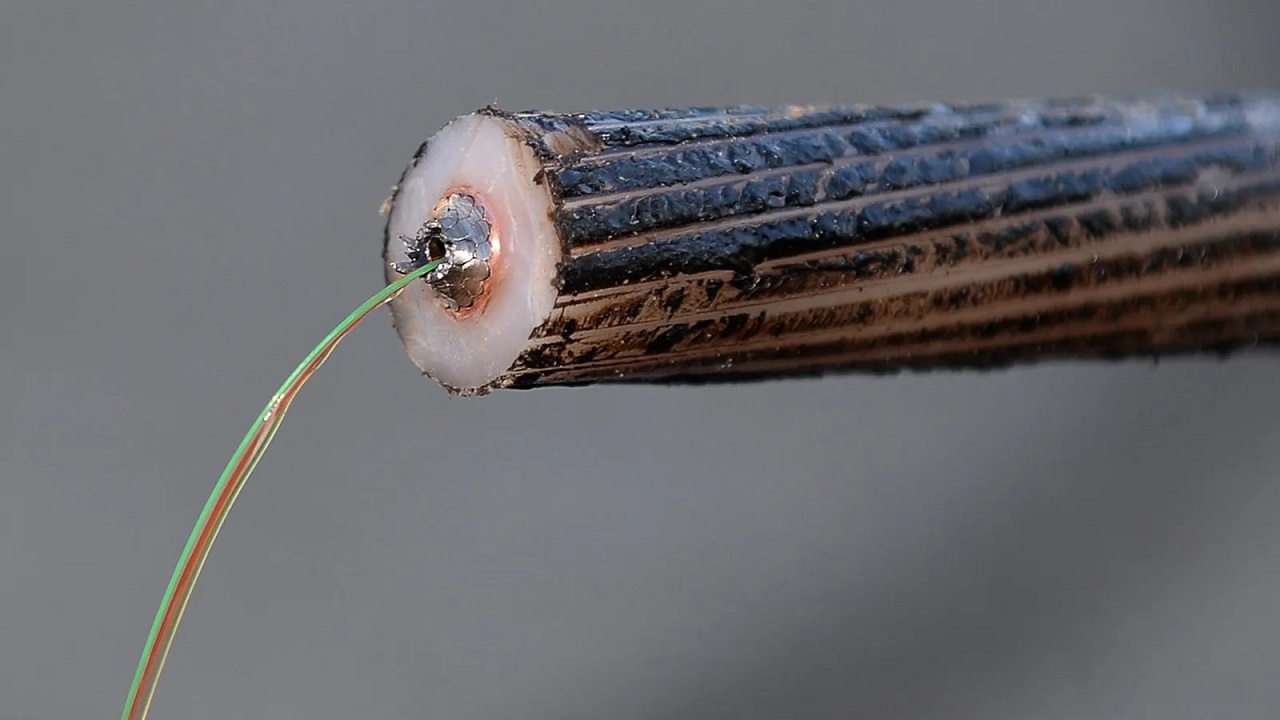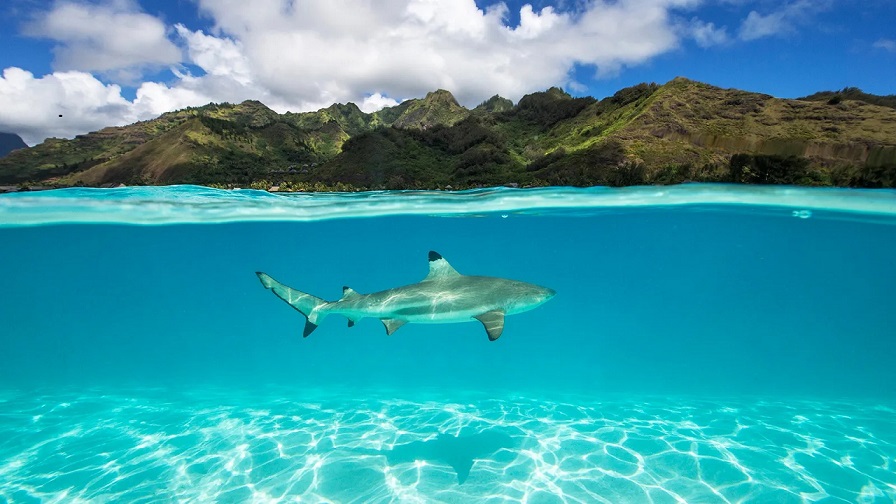 海底电缆可能对海洋生物造成什么影响?
海底电缆可能对海洋生物造成什么影响?
How undersea cables may affect marine life
译文简介
海底电缆可能对海洋生物造成什么影响。
正文翻译
Submarine cables carry electricity and information across vast oceans and seas, but we're only beginning to understand their possible impact on delicate marine life.
海底电缆传输的电力和信息穿越浩瀚的海洋,但我们只是初步认识到,海底电缆对脆弱的海洋生物造成的潜在影响。
海底电缆传输的电力和信息穿越浩瀚的海洋,但我们只是初步认识到,海底电缆对脆弱的海洋生物造成的潜在影响。
Tens of thousands of miles of cables crisscross our deep seas, ferrying data between continents and carrying renewable power from offshore energy platforms to the land. These snaking, artificial structures can serve as shelter to a vast array of bottom-dwelling sea life: anemones, sponges, corals, sea stars, urchins, worms, bivalves, crabs and other invertebrates have been found to take up residence on or near undersea cables.
数万英里的电缆在我们的深海里纵横交错,在各大陆间传输数据,将海上能源平台的可再生能源输送到陆地。这些蜿蜒的人工设施会成为大量底栖生物的居所:海葵、海绵、珊瑚、海星、海胆、蠕虫、双壳贝、螃蟹及其他无脊椎动物都被发现栖息在海底电缆的上面或附近。
数万英里的电缆在我们的深海里纵横交错,在各大陆间传输数据,将海上能源平台的可再生能源输送到陆地。这些蜿蜒的人工设施会成为大量底栖生物的居所:海葵、海绵、珊瑚、海星、海胆、蠕虫、双壳贝、螃蟹及其他无脊椎动物都被发现栖息在海底电缆的上面或附近。
But marine scientists believe we need a greater understanding of how electromagnetic fields (EMF) generated by submarine power cables might affect some of these delicate creatures, many of which rely on their own internal sense of magnetic north to navigate or use electric fields to help them hunt. Given that the number of submarine cables will only multiply as the marine renewable energy sector grows, what threats do they pose to life underwater, one of the last spots on Earth largely untouched by humans?
然而海洋科学家认为,我们需要深入了解海底电缆产生的电磁场对某些脆弱生物可能造成的影响,许多生物依靠自身对磁北的感知来进行导航,或者利用电磁场帮助他们捕捉猎物。考虑到随着海洋可再生能源行业的发展,海底电缆的数量只会有增无减,它们对海底生物构成什么威胁?海底是地球上基本尚未被人类探索的最后盲区之一。
然而海洋科学家认为,我们需要深入了解海底电缆产生的电磁场对某些脆弱生物可能造成的影响,许多生物依靠自身对磁北的感知来进行导航,或者利用电磁场帮助他们捕捉猎物。考虑到随着海洋可再生能源行业的发展,海底电缆的数量只会有增无减,它们对海底生物构成什么威胁?海底是地球上基本尚未被人类探索的最后盲区之一。
Undersea cables can be divided into two broad categories: telecommunication cables and high-voltage power cables. Telecommunications cables are laid on the surface of the seabed where they cross deep seas, while power cables, which tend to be found closer to shore, are typically buried under sediment for protection. Today, around 380 underwater telecommunications cables are in operation around the world, spanning a length of over 1.2 million kilometres (745,000 miles). This map shows all active subsea fibre-optic telecommunications cables – many of them featuring whimsical names like Apricot, Concerto, Topaz, Polar Express or Meltingpot.
海底电缆可分两大类:通信电缆和高压电力电缆。通信电缆铺设在海床表面并穿越深海,电力电缆一般比较靠近海岸,通常埋设在沉积物下面得到保护。当今世界约有380条海底通信电缆投入使用,全长超过120万千米(745000英里)。这张地图显示了所有活跃的海底光纤通信电缆,其中许多被冠以稀奇古怪的名字,例如杏子、协奏曲、黄玉、极地特快、坩埚。
海底电缆可分两大类:通信电缆和高压电力电缆。通信电缆铺设在海床表面并穿越深海,电力电缆一般比较靠近海岸,通常埋设在沉积物下面得到保护。当今世界约有380条海底通信电缆投入使用,全长超过120万千米(745000英里)。这张地图显示了所有活跃的海底光纤通信电缆,其中许多被冠以稀奇古怪的名字,例如杏子、协奏曲、黄玉、极地特快、坩埚。
Telecommunications cables provide the information pathways for more than 95% of international data. And offshore wind and hydrokinetic power plants also rely on submarine cables. Over the past few decades, as renewable energy projects proliferate, researchers have begun studying their environmental effects.
通信电缆为95%以上的国际数据提供信息通道,离岸风力发电厂和水力发电厂也有赖于海底电缆。过去几十年来,随着可再生能源项目日益增多,研究人员开始研究海底电缆的环境影响。
通信电缆为95%以上的国际数据提供信息通道,离岸风力发电厂和水力发电厂也有赖于海底电缆。过去几十年来,随着可再生能源项目日益增多,研究人员开始研究海底电缆的环境影响。
For most of its journey along the ocean floor, a telecommunications cable is about as wide as a garden hose, its digital data-carrying filaments no larger in diameter than a human hair. Power cables are generally larger in size (between 7-30 cm/2.75-12in) and are sheathed in a few layers of metal for enhanced protection. Subsea cables are carefully routed to avoid hazards that could damage them, such as earthquakes and underwater landslides. To minimise any accidental damage that may occur in shallower waters (for example, damage caused by human activities such as fishing, ocean trawling and anchoring), cables must be buried below the seafloor.
海床上的大部分通信电缆约有花园浇水软管那么粗,传输数据的光纤丝不超过人类头发的直径。电力电缆通常尺寸更大(7-30厘米/2.75-12英寸),表面覆盖多层金属来增强保护。海底电缆的铺设路线受到精心规划,以避免自然灾害对它们造成破坏,例如地震和海底滑坡。为了尽可能减少浅水区可能发生的意外破坏(例如钓鱼、拖网捕鱼、抛锚等人类活动造成的破坏)电缆必须铺设在海床下面。
海床上的大部分通信电缆约有花园浇水软管那么粗,传输数据的光纤丝不超过人类头发的直径。电力电缆通常尺寸更大(7-30厘米/2.75-12英寸),表面覆盖多层金属来增强保护。海底电缆的铺设路线受到精心规划,以避免自然灾害对它们造成破坏,例如地震和海底滑坡。为了尽可能减少浅水区可能发生的意外破坏(例如钓鱼、拖网捕鱼、抛锚等人类活动造成的破坏)电缆必须铺设在海床下面。

In shallower water, boats may be prohibited from coming near cables, which can result in healthier fish stocks.
在浅水区,可以禁止船只靠近电缆,使鱼类资源更加健康。
"During subsea installation, companies will try to bury a [power] cable beneath the sediment to protect it," says Bastien Taormina, a researcher at the Norwegian Institute of Marine Research in Bergen. "This has a much bigger impact on the surrounding habitat." Taormina is the lead author of an oft-cited study on the effects of artificial structures on marine ecosystems, published in the Journal of Environmental Management. Over a span of five years, he and his team studied the submarine power cable of a tidal energy test, taking pictures of species that colonised the cable and associated structures.
“在铺设海底电缆过程中,公司会将电力电缆埋设在沉积物下面来获得保护”,卑尔根的挪威海洋研究所的研究人员巴斯蒂安·陶尔米纳说道。“这对周围的栖息地有很大影响”。陶尔米纳主笔过一篇关于人工设施对海洋生态系统的影响的研究报告,并发表在《环境管理杂志》上。在五年时间里,他和他的团队研究了潮汐能试验中使用的海洋电力电缆,研究了栖息在电缆和相关设施上的物种。
原创翻译:龙腾网 https://www.ltaaa.cn 转载请注明出处
“在铺设海底电缆过程中,公司会将电力电缆埋设在沉积物下面来获得保护”,卑尔根的挪威海洋研究所的研究人员巴斯蒂安·陶尔米纳说道。“这对周围的栖息地有很大影响”。陶尔米纳主笔过一篇关于人工设施对海洋生态系统的影响的研究报告,并发表在《环境管理杂志》上。在五年时间里,他和他的团队研究了潮汐能试验中使用的海洋电力电缆,研究了栖息在电缆和相关设施上的物种。
原创翻译:龙腾网 https://www.ltaaa.cn 转载请注明出处
Installation of a cable disturbs the surrounding seabed. Somewhat paradoxically, that can lead to greater initial biodiversity, says Taormina. "Opportunistic species will survive, but that doesn't mean it's a good ecosystem, because these species, while diverse, won’t stick around." This phenomenon is what's known as ecological succession: the process by which communities gradually replace one another until a "climax community" – such as a mature coral reef – is reached, or until a disturbance, like a fire (or in this case an electrified submarine cable), occurs.
铺设电缆会干扰周围的海床,但有些矛盾的是,这可以促进初期的生物多样性,陶尔米纳说道。“机会物种能够存活,但并不意味着这是良好的生态系统,因为尽管这些物种是多样性的,但不会固定不变”。这种现象称为生态演替:一个群落逐渐替代另一个群落,最终达到“顶级群落”,例如成熟的珊瑚礁;或者最终发生生态失调,例如火灾(我们探讨的情形是通电的海底电缆)。
铺设电缆会干扰周围的海床,但有些矛盾的是,这可以促进初期的生物多样性,陶尔米纳说道。“机会物种能够存活,但并不意味着这是良好的生态系统,因为尽管这些物种是多样性的,但不会固定不变”。这种现象称为生态演替:一个群落逐渐替代另一个群落,最终达到“顶级群落”,例如成熟的珊瑚礁;或者最终发生生态失调,例如火灾(我们探讨的情形是通电的海底电缆)。
With nearly all of the world’s internet and banking transactions conducted over underwater cables, there is growing concern about their vulnerability.
由于世界上几乎所有的网络交和银行交易都经由海底电缆来完成,海底电缆的脆弱性越来越令人担忧。
由于世界上几乎所有的网络交和银行交易都经由海底电缆来完成,海底电缆的脆弱性越来越令人担忧。
Another possible consequence of undersea power cables is their generation of electromagnetic fields (EMF). The intensity of EMF is a direct function of the current passing through a cable and the depth at which it is buried, as well as the distance between cables (if multiple cables are running in close proximity, for example). EMF can distort the natural geomagnetic field that marine organisms rely on to navigate, particularly if they swim or drift 10 metres near the cables.
海底电力电缆造成的另一个潜在后果是电磁场。电磁场的强度取决于电缆中的电流强度、埋设电缆的深度、电缆的间距(例如多条电缆靠近彼此)。电磁场会干扰海洋生物赖以导航的天然地磁场,尤其是当它们在距离电缆10米内游弋或漂泊的时候。
原创翻译:龙腾网 https://www.ltaaa.cn 转载请注明出处
海底电力电缆造成的另一个潜在后果是电磁场。电磁场的强度取决于电缆中的电流强度、埋设电缆的深度、电缆的间距(例如多条电缆靠近彼此)。电磁场会干扰海洋生物赖以导航的天然地磁场,尤其是当它们在距离电缆10米内游弋或漂泊的时候。
原创翻译:龙腾网 https://www.ltaaa.cn 转载请注明出处
"There is a need to further study electro-magnetically susceptible species," says Michael Clare, leader of Marine Geosystems at the National Oceanography Centre. "What's the threshold at which EMF presents a problem for these sea creatures?" Most institutions and scientists (including Clare) are hesitant to make any causal lix between subsea cables and the behaviour of marine organisms.
“我们需要深入研究那些容易受到电磁影响的物种”,国家海洋学中心海洋地理系统部门的负责人迈克尔·克莱尔说道。“电磁场给这些海洋生物造成麻烦的阈值是多少”?大多数机构和科学家(包括克莱尔)不愿在海底电缆和海洋生物的行为之间建立因果联系。
“我们需要深入研究那些容易受到电磁影响的物种”,国家海洋学中心海洋地理系统部门的负责人迈克尔·克莱尔说道。“电磁场给这些海洋生物造成麻烦的阈值是多少”?大多数机构和科学家(包括克莱尔)不愿在海底电缆和海洋生物的行为之间建立因果联系。
"It has been suggested that behavioural movements in organisms such as skates and lobsters can be affected by EMFs, but whether they are affected by the EMF intensities generated by power cables remains unclear and the subject of ongoing research," Clare adds.
“有人认为,鳐鱼和龙虾等生物的行为运动会受到电磁场的影响,但尚不清楚它们会不会受到电力电缆产生的电磁场的影响,这个课题还需进一步研究”,克莱尔继续说道。
“有人认为,鳐鱼和龙虾等生物的行为运动会受到电磁场的影响,但尚不清楚它们会不会受到电力电缆产生的电磁场的影响,这个课题还需进一步研究”,克莱尔继续说道。
After completing several impact studies, the US Department of the Interior noted that "brief lingering activity near undersea cables have been observed, the data do not currently support a finding that overall navigational capabilities in fish are impaired". Much of the available peer-reviewed field studies performed to date also support this statement.
美国内政部在完成多次影响研究后指出,“观察到海底电缆周围有短暂的徘徊行为,但当前数据不支持鱼类的总体导航能力受损的研究结果”。迄今经过同行评审的大部分实地研究也支持这种说法。
美国内政部在完成多次影响研究后指出,“观察到海底电缆周围有短暂的徘徊行为,但当前数据不支持鱼类的总体导航能力受损的研究结果”。迄今经过同行评审的大部分实地研究也支持这种说法。

Telecommunications cables provide the information pathways for more than 95% of international data.
通信电缆为95%以上的国际数据提供了信息通道。
In experimental studies performed in aquariums, marine organisms sensitive to magnetic fields have been shown to exhibit behavioural responses to EMF, although at exposure levels far larger than those emitted by power cables. But sharks, rays and chimaeras, for example, are known to have evolved organs that are exquisitely sensitive to electrical fields: the ampullae of Lorenzini. These electroreceptors form a network of mucous-filled pores in the skin of cartilaginous fish – highly specialised organs optimised to detect prey, and that have a threshold sensitivity of less than a single microvolt.
在水族馆进行的试验性研究中,对磁场敏感的海洋生物对电磁场表现出行为反应,只是接触强度远大于电力电缆释放的电磁场强度。但鲨鱼、鳐鱼、银鲛等生物拥有一种进化而来的器官对电场极其敏感:劳伦氏壶腹。这些电感受器在软骨鱼类的皮肤表面形成一张由充满粘液的孔隙组成的网状物,这种极其特殊的器官可用来探测猎物,对电场的阈灵敏度不到1微伏。
在水族馆进行的试验性研究中,对磁场敏感的海洋生物对电磁场表现出行为反应,只是接触强度远大于电力电缆释放的电磁场强度。但鲨鱼、鳐鱼、银鲛等生物拥有一种进化而来的器官对电场极其敏感:劳伦氏壶腹。这些电感受器在软骨鱼类的皮肤表面形成一张由充满粘液的孔隙组成的网状物,这种极其特殊的器官可用来探测猎物,对电场的阈灵敏度不到1微伏。
"Future field studies – particularly that represent a collaboration between ocean researchers and cable operators and owners – will help further our understanding," says Clare. Taormina's study suggests animals that migrate along the continental shelves might be affected by a cable's electromagnetic field, moving either inshore or offshore away from their normal path, but he also agrees that more study on EMF is needed.
“未来的实地研究——尤其是在海洋研究人员和电缆运营商及用户之间开展合作——将有助于深化我们的认识”,克莱尔说道。陶尔米纳的研究表明,沿着大陆架迁移的海洋生物可能受到电缆的电磁场影响,使它们从正常路线向沿岸或近海偏离,但他也同意应该对电磁场进行更多的研究。
“未来的实地研究——尤其是在海洋研究人员和电缆运营商及用户之间开展合作——将有助于深化我们的认识”,克莱尔说道。陶尔米纳的研究表明,沿着大陆架迁移的海洋生物可能受到电缆的电磁场影响,使它们从正常路线向沿岸或近海偏离,但他也同意应该对电磁场进行更多的研究。
While studies of the deep sea are expensive, time-consuming and resource-heavy, they can help fill that information gap. Almost two decades ago, researchers at the Monterey Bay National Marine Sanctuary, in collaboration with the National Oceanic and Atmospheric Administration (NOAA), conducted a survey of a seamount thermometry cable on the deep seafloor off the coast of central California – a survey considered unique at the time for investigating the biological impact of subsea cables. Remote operated vehicles (ROVs) carried electronic cable-tracking systems into the deep waters of Half Moon Bay, allowing researchers to find parts of the cable that had been buried under sediment (the cable was initially laid down in 1995 as part of an experiment to detect changes in ocean temperature by monitoring the speed of sound waves in the deep sea). As the ROVs scanned the cable’s roughly 95-kilometre (59-mile) length, scientists collected sediment samples, video and still images of animals living on or near the cable.
尽管深海研究昂贵耗时,需要投入大量资源,但有助于填补这个信息缺口。大约20年前,蒙特雷湾国家海洋保护区与国家海洋和大气管理局展开合作,研究了加州中部沿海深处的海底山测温电缆,当时被视为针对海底电缆生态影响的独有研究。无人遥控潜水器携带电缆追踪电子设备潜入半月湾的深海,使研究人员找到埋设在沉积物下面的部分电缆(1995年开始铺设这条用于试验的电缆,通过监测深海声波的速度来探测海洋温度的变化)。随着无人遥控潜水器扫描了长度约95千米(59英里)的电缆,科学家收集了沉积物的样本,对栖息在电缆上面或附近的动物拍摄了视频和静态照片。
尽管深海研究昂贵耗时,需要投入大量资源,但有助于填补这个信息缺口。大约20年前,蒙特雷湾国家海洋保护区与国家海洋和大气管理局展开合作,研究了加州中部沿海深处的海底山测温电缆,当时被视为针对海底电缆生态影响的独有研究。无人遥控潜水器携带电缆追踪电子设备潜入半月湾的深海,使研究人员找到埋设在沉积物下面的部分电缆(1995年开始铺设这条用于试验的电缆,通过监测深海声波的速度来探测海洋温度的变化)。随着无人遥控潜水器扫描了长度约95千米(59英里)的电缆,科学家收集了沉积物的样本,对栖息在电缆上面或附近的动物拍摄了视频和静态照片。
In silty areas, the most obvious biological effects of the cable were the neat lines of sea anemones that researchers discovered growing on the cable itself. Frequently, these sea anemones were attached directly to parts of the cable that had been buried under mud or silt. Researchers concluded that these anemones likely would not have been able to colonise such soft-bottom areas without the presence of the seafloor cable, which provided a firm footing for the animals. Removal of such cables would therefore affect a small ecosystem of marine creatures who call that cable home.
在粉砂区域,研究人员发现电缆上生长着排列整齐的海葵,这是电缆对生态造成的最明显影响。这些海葵经常直接依附在被埋设在淤泥或粉砂下面的部分电缆上。研究人员的结论是,如果不是海底电缆为海葵提供了坚实的立足之地,它们可能无法移居到这种软质的海底区域。因此,拆除这种电缆会影响海洋生物的小型生态系统,它们把电缆当成了家园。
在粉砂区域,研究人员发现电缆上生长着排列整齐的海葵,这是电缆对生态造成的最明显影响。这些海葵经常直接依附在被埋设在淤泥或粉砂下面的部分电缆上。研究人员的结论是,如果不是海底电缆为海葵提供了坚实的立足之地,它们可能无法移居到这种软质的海底区域。因此,拆除这种电缆会影响海洋生物的小型生态系统,它们把电缆当成了家园。

Certain sea creatures, such as sharks and rays, seem to be more sensitive to the electrical signals sent out by some cables.
某些海洋生物,例如鲨鱼和鳐鱼,似乎对电缆发出的电信号比较敏感。
原创翻译:龙腾网 https://www.ltaaa.cn 转载请注明出处
Beyond localised habitat damage or loss, submarine power and communication cables may temporarily or permanently impact the marine environment through heat, turbidity (during cable burial), risk of entanglement and the introduction of artificial substrates. Still, areas through which cables pass are often designated as protected, meaning anchors, bottom trawls and even fishing can be restricted. The Cook Strait Cable Protection Zone (CPZ) in New Zealand, for example, restricts fishing near cables, effectively creating a reserve and thus improving fish stocks.
除了局部栖息地受损或消失,海底电力和通信电缆可能对海洋环境造成暂时或永久性影响,原因包括热量、浑浊(在埋设电缆期间)、缠绕风险、人工海底。然而,铺设电缆的地方通常被定为保护区,这意味着船锚、海底拖网、甚至钓鱼受到限制。例如,新西兰的“库克海峡电缆保护区”限制电缆附近的钓鱼活动,有效形成了保护区,从而改善鱼类资源。
原创翻译:龙腾网 https://www.ltaaa.cn 转载请注明出处
除了局部栖息地受损或消失,海底电力和通信电缆可能对海洋环境造成暂时或永久性影响,原因包括热量、浑浊(在埋设电缆期间)、缠绕风险、人工海底。然而,铺设电缆的地方通常被定为保护区,这意味着船锚、海底拖网、甚至钓鱼受到限制。例如,新西兰的“库克海峡电缆保护区”限制电缆附近的钓鱼活动,有效形成了保护区,从而改善鱼类资源。
原创翻译:龙腾网 https://www.ltaaa.cn 转载请注明出处
And submarine cables do not pollute: they are stable, inert structures that can even be recovered and recycled after they've served their time (about 20-40 years, on average). "The carbon footprint is actually relatively low compared to most of the internet’s infrastructure," says Nicole Starosielski,associate professor at NYU. Her book, The Undersea Network, examines the cultural and environmental dimensions of transoceanic cable systems, and she adds an important social science perspective to the discussion. "We've actually advocated for more cables, connecting large onshore data centers on renewable grids, in order to minimise fossil fuel consumption."
海底电缆不会造成污染:它具有稳定惰性的结构,使用寿命结束后甚至能被找到和回收利用(平均寿命大约20-40年)。“海底电缆的碳足迹其实低于大多数互联网基础设施”,纽约大学副教授妮可·斯塔罗斯基说道。她的著作《海底纽约》从文化和环境层面考察了跨洋电缆系统,在论述中新增了重要的社会科学视角。“我们其实提倡铺设更多的电缆,与可再生能源电网上巨大的陆地数据中心相连,以达到尽量减少使用化石燃料的目的”。
原创翻译:龙腾网 https://www.ltaaa.cn 转载请注明出处
海底电缆不会造成污染:它具有稳定惰性的结构,使用寿命结束后甚至能被找到和回收利用(平均寿命大约20-40年)。“海底电缆的碳足迹其实低于大多数互联网基础设施”,纽约大学副教授妮可·斯塔罗斯基说道。她的著作《海底纽约》从文化和环境层面考察了跨洋电缆系统,在论述中新增了重要的社会科学视角。“我们其实提倡铺设更多的电缆,与可再生能源电网上巨大的陆地数据中心相连,以达到尽量减少使用化石燃料的目的”。
原创翻译:龙腾网 https://www.ltaaa.cn 转载请注明出处
Indeed, small developing island states are crucially tethered to these elaborate cable systems, without which they would struggle to obtain green energy, telecommunications, remote-work technology, e-medicine and other digital services. Ocean life – and its often-complex interaction with human activities – is riddled with unknowns; for ecologists worried about environmental conservation, these subsea cables remain a serpentine question mark.
事实上,小岛屿发展中国家与这些复杂的电缆系统至关重要地捆绑在一起,否则他们难以获取绿色能源、通信、远程办公技术、电子医疗及其他数字化服务。海洋生物——及其与人类活动之间的复杂互动——充满了谜团;对于担心环保的生态学家来说,这些海底电缆仍是一个曲折的问号。
事实上,小岛屿发展中国家与这些复杂的电缆系统至关重要地捆绑在一起,否则他们难以获取绿色能源、通信、远程办公技术、电子医疗及其他数字化服务。海洋生物——及其与人类活动之间的复杂互动——充满了谜团;对于担心环保的生态学家来说,这些海底电缆仍是一个曲折的问号。
But, as Clare explains: "There is value in the research, which will help industry leaders, policy-makers, cable companies and other parts of the wider Blue Economy strive to ensure any development of the seafloor is as sustainable as possible."
但正如克莱尔所言:“这方面的研究是有价值的,有助于行业领袖、决策者、电缆企业、以及蓝色经济(循环经济)的其他参与者尽量确保海床的可持续性发展”。
但正如克莱尔所言:“这方面的研究是有价值的,有助于行业领袖、决策者、电缆企业、以及蓝色经济(循环经济)的其他参与者尽量确保海床的可持续性发展”。
评论翻译
很赞 ( 2 )
收藏